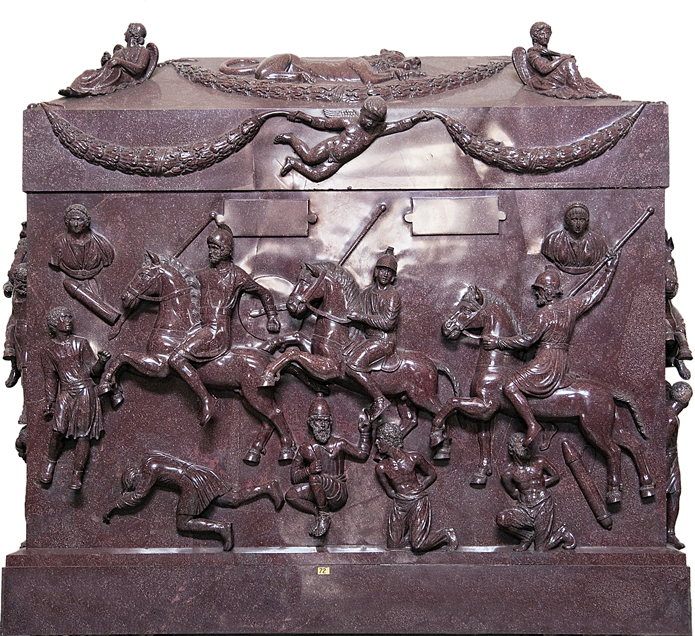A History of World Societies:
Printed Page 214
A History of World Societies Value
Edition: Printed Page 210
Chapter Chronology
The Evolution of Church Leadership and Orthodoxy
Believers in early Christian communities chose their own leaders, but as the centuries passed appointment by existing church leaders or secular rulers became the common practice. During the reign of Diocletian (r. 284–305), the Roman Empire had been divided for administrative purposes into geographical units called dioceses, and Christianity adopted this pattern. Each diocese was headed by a bishop, who was responsible for organizing preaching, overseeing the community’s goods, maintaining orthodox (established or correct) doctrine, and delegating responsibilities for preaching and teaching. The center of a bishop’s authority was his cathedral, a word deriving from the Latin cathedra, meaning “chair.”
The early Christian Church benefited from the administrative abilities of church leaders. Bishop Ambrose of Milan (339–397) was typical of the Roman aristocrats who held high public office, converted to Christianity, and subsequently became bishops. Like many bishops, Ambrose had a solid education in classical law and rhetoric, which he used to become an eloquent preacher. He had a strong sense of his authority and even stood up to Emperor Theodosius (r. 379–395), who had ordered Ambrose to hand over his major church — called a basilica — to the emperor:

Sarcophagus of Helena This marble sarcophagus was made for Helena, the mother of Emperor Constantine, at her death. Its detailed carvings show victorious Roman horsemen and barbarian prisoners. Like her son, Helena became a Christian, and she was sent by Constantine on a journey to bring sacred relics from Jerusalem to Constantinople as part of his efforts to promote Christianity in the empire. (© Vanni Archive/Art Resource, NY)
At length came the command, “Deliver up the Basilica”; I reply, “It is not lawful for us to deliver it up, nor for your Majesty to receive it. By no law can you violate the house of a private man, and do you think that the house of God may be taken away? . . . But do not burden your conscience with the thought that you have any right as Emperor over sacred things. . . . It is written, God’s to God and Caesar’s to Caesar. The palace is the Emperor’s, the churches are the Bishop’s. To you is committed jurisdiction over public, not over sacred buildings.”2
The emperor relented. Ambrose’s assertion that the church was supreme in spiritual matters and the state in secular issues was to serve as the cornerstone of the church’s position on church-state relations for centuries. Because of his strong influence, Ambrose came to be regarded as one of the “fathers of the church,” that is, early Christian thinkers whose authority was regarded as second only to the Bible in later centuries.
Although conflicts like these between religious and secular leaders were frequent, the church also received support from the emperors. In 380 Theodosius made Christianity the official religion of the empire, and later in his reign he authorized the closure or destruction of temples and holy sites dedicated to the traditional Roman and Greek gods. In return for such support, the emperors expected the Christian Church’s assistance in maintaining order and unity.
Christians disagreed with one another about many issues, which led to schisms (SKIH-zuhms), denunciations, and sometimes violence. In the fourth and fifth centuries disputes arose over the nature of Christ. For example, Arianism, developed by Arius (ca. 250–336), a priest of Alexandria, held that Jesus was created by the will of God the Father and thus was not co-eternal with him. Arian Christians reasoned that Jesus the Son must be inferior to God the Father, because the Father was incapable of suffering and did not die. Emperor Constantine, who legalized Christianity in 312, rejected the Arian interpretation and decided that religious disagreement meant civil disorder. In 325 he summoned a council of church leaders to Nicaea in Asia Minor and presided over it personally. The council produced the Nicene (nigh-SEEN) Creed, which defined the position that Christ is “eternally begotten of the Father” and of the same substance as the Father. Arius and those who refused to accept Nicene Christianity were banished. Their interpretation of the nature of Christ was declared a heresy, that is, a belief that contradicted the interpretation the church leaders declared was correct, which was termed orthodoxy. These actions did not end Arianism, however. Several later emperors were Arian Christian, and Arian missionaries converted many barbarian tribes who were attracted by the idea that Jesus was God’s second-in-command, which fit well with their own warrior hierarchies and was less complicated than the idea of two persons with one substance. The Nicene interpretation eventually became the most widely held understanding of the nature of Christ, however, and is accepted today by the Roman Catholic Church, the Eastern Orthodox Churches, and most Protestant Churches.
The Nicene Creed says little specifically about the Holy Spirit, but in the following centuries the idea that the Father, Son, and Holy Spirit are “one substance in three persons” — the Trinity — became a central doctrine in Christianity, though again there were those who disagreed. Disputes about the nature of Christ also continued, with factions establishing themselves as separate Christian groups. The Nestorians, for example, regarded the divine and human natures in Jesus as distinct from one another, whereas the orthodox opinion was that they were united. The Nestorians split from the rest of the church in the fifth century after their position was outlawed and settled in Persia. Nestorian Christian missionaries later founded churches in Central Asia, India, and China (see Chapter 12).
